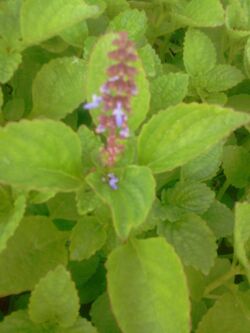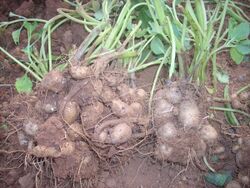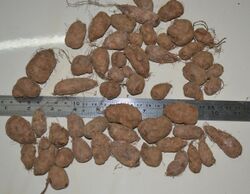Biology:Plectranthus rotundifolius
| Plectranthus rotundifolius | |
|---|---|

| |

| |
| Scientific classification | |
| Kingdom: | Plantae |
| Clade: | Tracheophytes |
| Clade: | Angiosperms |
| Clade: | Eudicots |
| Clade: | Asterids |
| Order: | Lamiales |
| Family: | Lamiaceae |
| Genus: | Plectranthus |
| Species: | P. rotundifolius
|
| Binomial name | |
| Plectranthus rotundifolius | |
| Synonyms[1] | |
| |
Plectranthus rotundifolius or Solenostemon rotundifolius, commonly known as native or country potato in Africa and called Chinese potato in India , is a perennial herbaceous plant of the mint family (Lamiaceae) native to tropical Africa. It is cultivated for its edible tubers primarily in West Africa, as well as more recently in parts of Asia, especially India, Sri Lanka, Malaysia, and Indonesia.[2]
P. rotundifolius is closely related to the coleus plants widely cultivated as ornamentals and is often classified as a member of the genus Solenostemon rather than Plectranthus. It was formerly placed in the now-defunct genus Coleus, most of whose members have now been reassigned to the genus Solenostemon.
Names
In Africa, P. rotundifolius is also known as the Hausa potato or Sudan potato, in addition to the names native potato and country potato.[3]
Use and cultivation
The egg-shaped tubers of the native potato appear very similar to the unrelated true potato, though they are smaller than modern commercial varieties. They are typically boiled, but may also be roasted, baked, or fried. Their flavor is bland, but sweeter than P. esculentus.[2]
Native potato is overwhelmingly a subsistence crop, though flour milling is reported in Burkina Faso.[2]
P. rotundifolius is one of three Plectranthus species native to Africa grown for their edible tubers and using the same vernacular names. The others, P. esculentus and P. edulis, native to southern Africa and Ethiopia, respectively, have not spread beyond Africa. Its cultivation has been largely displaced by the spread of cassava, which was introduced by the Portuguese to Africa from South America about 500 years ago.[3]
Names
| Vernacular names of Plectranthus rotundifolius | ||
|---|---|---|
| Region | Language | Term |
| International and Europe | ||
| English | Chinese, country, Coleus, Frafra, Hausa, native, Sudan, or Zulu potato | |
| French | pomme de terre de Madagascar, du Soudan ou d'Afrique coléus à tubercules | |
| Africa | ||
| Chad | ngaboyo | |
| Dioula, Minianka | fabirama, fabourama | |
| Frafra (Gurenne) | pesa, pessa | |
| Hausa | tumuku | |
| Mandinka, Bambara |
fa-birama. fabirama (fabourama) usu ni gé (oussou-ni-gué) usu ni fin (oussou-ni-fing) | |
| Mossi (Mooré) | peinssa | |
| South Asia | ||
| Kannada | ಸಂಬ್ರಾಣಿ saṃbrāni (sambrani) | |
| Konkani | कूक kūka (kooka)
And झाड़े कणगा ( Jhade Kanaga) | |
| Malayalam | കൂർക്ക kūrkka (koorka, koorkka) | |
| Sinhala | ඉන්නල innala | |
| Tamil | சிறு கிழங்கு ciṟu kiḻaṅku (siru kizhangu) | |
| South East Asia | ||
| Thai | มันขี้หนู, man khee nuu | |
| Indonesian | kentang hitam, Jawa, or kleci | |
| Javanese | kentang ireng | |
| Malay | ubi keling, ubi kemili | |
See also
- Plectranthus esculentus (Livingstone potato)
References
- ↑ "The Plant List: A Working List of All Plant Species". http://www.theplantlist.org/tpl1.1/record/kew-158453. Retrieved 12 June 2015.
- ↑ 2.0 2.1 2.2 National Research Council (2006). Lost crops of Africa: Volume II: Vegetables. Washington, D.C.: National Academies Press. pp. 269–285. ISBN 0-309-66582-5.
- ↑ 3.0 3.1 Blench, Roger (2006). Archaeology, language, and the African past. Altamira Press. ISBN 9780759104655.
Wikidata ☰ Q2716687 entry



